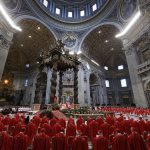This Sunday, the Eleventh Sunday in Ordinary Time, we encounter the famous parable of the mustard seed. Through this parable, Christ tells us that the kingdom of God is like a mustard seed. “[W]hen it is sown in the ground, [it] is the smallest of all the seeds on the earth. But once it is sown, it springs up and becomes the largest of plants and puts forth large branches, so that the birds of the sky can dwell in its shade.”
I would like to think with you about Christ’s parable of the mustard seed in terms of the Church. Over the past several weeks, we have celebrated the Church’s “birthday” at Pentecost and her intimate, life-giving communion with God on Trinity Sunday and the feast of Corpus Christi. Today, we are invited to think about the Church in light of the mustard seed; even as a mustard seed.
|
Ez 17:22-24 Ps 92:2-3, 13-14, 15-16 2 Cor 5:6-10 Mk 4:26-34 |
“A time for growing.” This is the phrase every child in a Catechesis of the Good Shepherd Atrium learns to use to describe Ordinary Time. From just 3 years old, these children have a point of entry into Christ’s parable of the mustard seed. Like a “seed” or a “tender shoot” (cf. Ezekiel), we need to grow. And, if planted within the Church, with God himself as our gardener, we do!
Of course, if one learns this way of thinking at age 3, one also has a lot of growing up to do! And so the parable continues to apply to us all when thought of as an image of spiritual growth. One of the earliest theologians to contemplate the Church was St. Irenaeus, bishop of Lyon (d. 202). He describes the soul as child-like and needing to grow toward its perfection its whole life long. Our growth occurs, then, through our ability to love: to always choose to love God and neighbor no matter the cost. Christ, Irenaeus says, shows us how to do this, and nourishes us along our way with the Eucharist.
Looking at the early Church
So far, we have looked at the Church in light of the mustard seed as it could be understood in her individual members. Together with Christ, these individual members are united as the Church. And so let us now think about the Church as a mustard seed. For this, too, we will think about the early Church.
The Church started out small, like the mustard seed. It was Christ and his mother, and then his disciples, and then the others whom the Gospels tell us about. Soon the disciples became apostles, and others joined them in spreading the Gospel; Stephen, for example, and Paul! The Church was growing, like a “tender shoot.”
It was not long, though, before the Church began to experience persecution. Indeed, we have already mentioned Stephen and Paul. But the Empire of Rome would try to trample down and root out this young “plant.” Yet, the Church did not “wither,” but grow! It is as if it “[sprang] up and [became] the largest of plants and [put] forth large branches.”
Tertullian (d. 220) was a young boy living in Northern Africa when Irenaeus was a bishop in Lyon. Both lived in situations of persecution. Tertullian has famously called the blood of the martyrs, “the seeds of the Church.” And Origen (d. 254), another early Church Father and confessor, offered the stunning rate of this growth amid persecution as a sign that the Church bears the true Gospel. Christ is her “seed” and her “fruit”!
Thus, the Church truly began as “one of the smallest seeds of the earth,” and has grown to spread her “great branches” across the whole earth. Wherever the Church is “sown in the ground” and nourished by Christ, she “springs up” to bear the fruit of the Gospel in the “shade” of her branches. It is “a time for growing”!
This post Ways the Faith has grown from a mustard seed appeared on Our Sunday Visitor.



